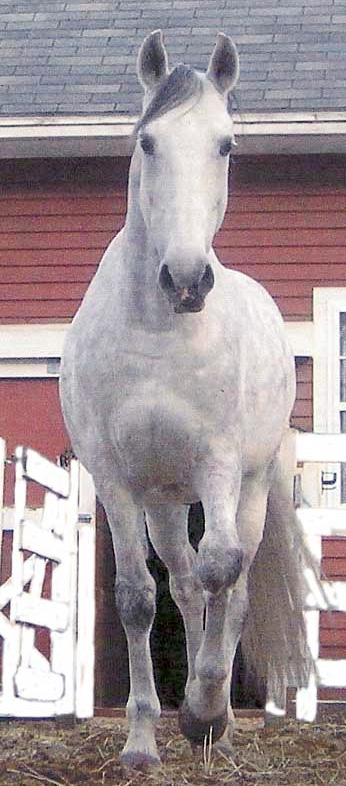Philosophy:
It's important for a teacher to pay attention to an individual's learning style in order to help them learn to ride as well as they can. How do you learn best? Are you a visual learner who learns best by seeing something done? Are you a kinesthetic learner who must feel something to learn it? Are you an auditory learner who learns best by hearing how something works? Are you unsure how you learn best? In learning about dressage and horseback riding all of your senses must be accessed to take instruction. I employ a variety of exercises both on and off of the horse to help a rider learn the "feel" of what they're looking for, as well as the "look".
With both adults and children I believe that a firm knowledge base is important to training. So if you are an individual who appreciates knowing the theory and technical aspects of what you're trying to achieve, you'll find that I'll help you to understand not only what you're doing, but why you're doing it.
For both the riders and their horses, I present a step by step reasoned approach, and believe that if something is not happening, there's often a step that has been missed. In some cases, there's an underlying issue (such as a misunderstanding or a bio-mechanical problem) that needs to be addressed before the rider and horse are successful, so I help the student to deal with that.
Learning to ride horses can be a fun, interesting and challenging experience. It can be personally transformative. I enjoy people as well as horses, and honestly believe that a supportive, but clear atmosphere helps the learning process of most individuals. Horses and riders need consistency and variation, structure and reward. Through the use of the training scale, the classical principles of dressage, and learning and training theory, the development of both individuals improves.
My wish is that my students become riders who can enjoy dancing with their equine partners!
It's important for a teacher to pay attention to an individual's learning style in order to help them learn to ride as well as they can. How do you learn best? Are you a visual learner who learns best by seeing something done? Are you a kinesthetic learner who must feel something to learn it? Are you an auditory learner who learns best by hearing how something works? Are you unsure how you learn best? In learning about dressage and horseback riding all of your senses must be accessed to take instruction. I employ a variety of exercises both on and off of the horse to help a rider learn the "feel" of what they're looking for, as well as the "look".
With both adults and children I believe that a firm knowledge base is important to training. So if you are an individual who appreciates knowing the theory and technical aspects of what you're trying to achieve, you'll find that I'll help you to understand not only what you're doing, but why you're doing it.
For both the riders and their horses, I present a step by step reasoned approach, and believe that if something is not happening, there's often a step that has been missed. In some cases, there's an underlying issue (such as a misunderstanding or a bio-mechanical problem) that needs to be addressed before the rider and horse are successful, so I help the student to deal with that.
Learning to ride horses can be a fun, interesting and challenging experience. It can be personally transformative. I enjoy people as well as horses, and honestly believe that a supportive, but clear atmosphere helps the learning process of most individuals. Horses and riders need consistency and variation, structure and reward. Through the use of the training scale, the classical principles of dressage, and learning and training theory, the development of both individuals improves.
My wish is that my students become riders who can enjoy dancing with their equine partners!

In their lessons, students learn:
* Safety practices and techniques for basic horse handling.
Techniques for leading, grooming, tacking up, mounting, lunging,
free-lunging, and some work in hand.
* Equitation and training theory.
How to apply the theory to practice in order to become a more
comfortable and effective rider or trainer.
* Dressage techniques in the saddle.
How to ride the different gaits, transitions and lateral movements.
Exercises and routines to help the horse become more supple,
attentive, confident and fit.
* Cavalletti exercises (and jumping techniques for some).
To develop balance, coordination, strength and timing of both horse
and rider.
* Dressage tests, jump courses and obstacle courses.
To challenge horse and rider, to develop goals, verify progress or
prepare for shows.
* Mounted exercises on the lunge line.
To improve the rider's balance, suppleness, coordination and
confidence.
* Exercises for riders on their own two feet.
To help understand and develop certain body coordination issues.
* Safety practices and techniques for basic horse handling.
Techniques for leading, grooming, tacking up, mounting, lunging,
free-lunging, and some work in hand.
* Equitation and training theory.
How to apply the theory to practice in order to become a more
comfortable and effective rider or trainer.
* Dressage techniques in the saddle.
How to ride the different gaits, transitions and lateral movements.
Exercises and routines to help the horse become more supple,
attentive, confident and fit.
* Cavalletti exercises (and jumping techniques for some).
To develop balance, coordination, strength and timing of both horse
and rider.
* Dressage tests, jump courses and obstacle courses.
To challenge horse and rider, to develop goals, verify progress or
prepare for shows.
* Mounted exercises on the lunge line.
To improve the rider's balance, suppleness, coordination and
confidence.
* Exercises for riders on their own two feet.
To help understand and develop certain body coordination issues.
LESLIE KORNFELD
DRESSAGE & RIDING INSTRUCTION
DRESSAGE & RIDING INSTRUCTION

www.lesliekornfeld.com Contact leslie@lesliekornfeld.com Phone: 978-461-2440
APPROACH TO RIDING INSTRUCTION AND TRAINING